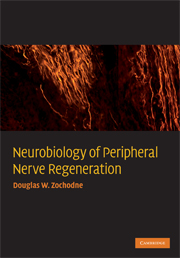Book contents
- Frontmatter
- Contents
- Acknowledgments
- 1 Introduction
- 2 The intact peripheral nerve tree
- 3 Injuries to peripheral nerves
- 4 Addressing nerve regeneration
- 5 Early regenerative events
- 6 Consolidation and maturation of regeneration
- 7 Regeneration and the vasa nervorum
- 8 Delayed reinnervation
- 9 Trophic factors and peripheral nerves
- 10 The nerve microenvironment
- References
- Index
- Plate section
- References
9 - Trophic factors and peripheral nerves
- Frontmatter
- Contents
- Acknowledgments
- 1 Introduction
- 2 The intact peripheral nerve tree
- 3 Injuries to peripheral nerves
- 4 Addressing nerve regeneration
- 5 Early regenerative events
- 6 Consolidation and maturation of regeneration
- 7 Regeneration and the vasa nervorum
- 8 Delayed reinnervation
- 9 Trophic factors and peripheral nerves
- 10 The nerve microenvironment
- References
- Index
- Plate section
- References
Summary
The concept that molecules can signal neurons and axons and convince them to behave in new, even innovative ways is exciting. Trophic factors are molecules, usually proteins, that act on specific cell receptors to induce changes in protein synthesis, outgrowth, or survival. In the nervous system, nerve growth factor (NGF) leads the classic family of growth factors known as “neurotrophins.” A working definition of a neurotrophin is “an endogenous soluble protein regulating survival, growth, morphologic plasticity or synthesis of proteins for differentiated function of neurons” [256]. NGF was discovered in 1951 by Rita Levi-Montalcini and subsequently characterized by Stanley Cohen, culminating in the award of the Nobel Prize in Physiology or Medicine in 1986 to both investigators [388,389]. Using sarcoma tumor in the mouse model, Levi-Montalcini and Viktor Hamburger established that NGF was a soluble factor from mouse sarcoma tumor that was capable of inducing hyperplasia in sympathetic ganglia [389,390](Figure 9.1). The original articles describing these discoveries are recommended and make for fascinating reading [390]:
The growth promoting effect of the tumor is mediated by a diffusible agent. This mode of action was suggested by the observation that sympathetic ganglia which are located rostrally to the tumor and not connected with the tumor by nerve fibers, are also conspicuously enlarged. The overgrowth of the ganglia is the combined result of an increase in cell number and in cell size. The enlarged ganglia send large sympathetic fiber bundles into the adjacent viscera. Branchial and abdominal viscera which normally receive only a sparse innervation or none at all are inundated with fiber masses during the second and third weeks of invasion.
- Type
- Chapter
- Information
- Neurobiology of Peripheral Nerve Regeneration , pp. 182 - 205Publisher: Cambridge University PressPrint publication year: 2008



